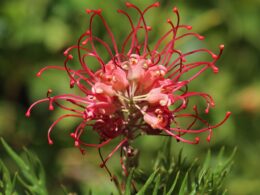What’s a Foam Flower Plant (Tiarella Cordifolia)?
A native plant of North America, the foam flower plant is a herbaceous perennial that belongs to the family Saxifragaceae. The plant gets its name from the foamy white flowers that appear in springtime. The leaves are simple and deeply lobed, and the plant spreads by runners.
Foam Flower Appearance
The leaves are 5–10 cm (2–4 in) long, basal, hairless, with 3-7 shallow lobes, and heart-shaped at the base. They are greenish brown, often with russet markings, rough-hairy above and downy beneath. They grow to a height of 30 cm (12 in) and have white, tiny fluffy flowers that bloom from the bottom up on a leafless stem.
Foam Flower Distribution and Habitat
Foam flower (Tiarella cordifolia) is a perennial plant that is native to North America. It typically grows in woodland areas, and can be found in the eastern United States and Canada.
Foam Flower Care
Foam flowers are relatively easy to care for, but there are a few things to keep in mind to ensure that they thrive. Here are some tips for caring for foam flowers
Water
Foam flowers are relatively drought tolerant once they are established. However, during the first growing season, they will benefit from regular watering to help them get established. After that, you can let the soil dry out somewhat between watering.
Soil
Foamflower plants thrive on fertile soil. For cultivating this plant, a moderately moisture-retentive, humusy loam or chalk should be used. The plants like neutral to slightly acidic soils that are usually in the range of 6.2 – 6.5 pH levels.
Light
The US Department of Agriculture lists foamflower plants as hardy in zones 3 to 9. The foam flower prefers partial shade but can also tolerate full sun, as long as the soil is kept moist.
Temperature
Foamflower plants are not tolerant of extreme heat or cold. They prefer cool temperatures and will go dormant in hot weather. If you live in an area with very hot summers, it’s best to plant foamflowers in a spot that gets some afternoon shade.
Fertilizing
Foamflower plants don’t require a lot of fertilizer. A light application of compost or an all-purpose fertilizer in the spring is usually sufficient. Too much fertilizer will result in leggy growth and fewer flowers.
Pruning
Although foam flowers don’t require much pruning, a light trimming in late spring can encourage bushier growth and more bountiful blooms. When pruning foam flowers, start by removing any dead or damaged stems. Next, cut back the tallest stems to promote more compact growth.
Foam Flower Propagation
Propagating foam flowers by seeds is the most common method. Sow the seeds in early spring on the surface of well-drained soil. Be sure to keep the soil moist until germination occurs. Once the seedlings have emerged, thin them out so that they are spaced about 15 inches apart. You can also propagate foam flower by taking root cuttings in late summer or early fall. Cuttings should be taken from young plants that have not yet flowered. Once the roots are established, you can transfer the plants to individual pots filled with regular potting soil.
Another option for propagating foam flowers is to divide established clumps in late fall. Using a sharp shovel, carefully dig up the entire plant and then gently pull it apart into several smaller clumps. Replant each clump immediately, making sure to space them about 15 inches apart. Whichever method you choose, propagating foam flower is a relatively easy process that will give you plenty of new plants to enjoy.
Foam Flower Pests and Diseases
Foam flowers are beautiful, low-maintenance plants that are perfect for adding a splash of color to any garden. However, like all plants, they are vulnerable to pests and diseases. Some of the most common foam flower pests include aphids, slugs, and snails. These pests can damage leaves and stems, preventing the plant from taking in nutrients and growing properly.
Foam flowers are also susceptible to powdery mildew, a type of fungal disease that causes the leaves to develop a white, powdery coating. If left untreated, powdery mildew can weaken the plant and make it more susceptible to other diseases.
Black Vine Weevils
The foam flower plant can also be affected by black vine weevils. These pests feed on the leaves of the plant, causing them to turn brown and die. If you suspect that your foam flower has black vine weevil damage, it is important to take action immediately. Removing the affected leaves and destroying them. You may also want to consider using an insecticide to kill any remaining weevils. With proper care and treatment, your foam flower should soon recover from black vine weevil damage.
How to Prevent Foam Flowers From Diseases?
Thankfully, there are a few simple steps that gardeners can take to prevent or control these problems. For example, regular inspection of plants can help to catch an infestation early, before it has a chance to do serious damage. In addition, planting foam flowers in well-drained soil and providing them with adequate airflow can help to prevent powdery mildew from taking hold. By taking these precautions, gardeners can keep their foam flowers healthy and thriving for years to come



















